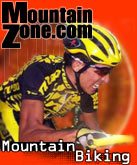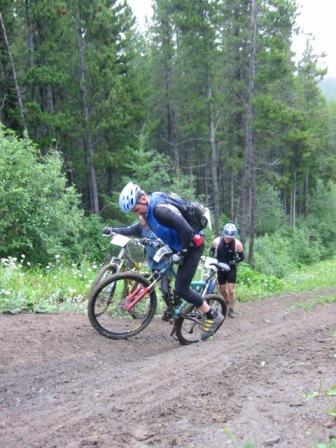
Tales of the One-Legged Wolf
Despite only having one-leg to ride with, Brett Wolf completes his 3rd TransRockies...
February 26, 2005

|
| Brett hiking his bike Photo by Garry Edmundson |
Why did I compete in the TransRockies Challenge race twice? Why race again? Simple, I want to go faster and see what the body and mind can dish out, and of course...spend some quality time in the mountains. For most of us, racing can be very personal. The desire to flog yourself and go further and faster than you thought possible defines your 'self'. Of course, beating your personal demons propels most of us beyond our competitors. First, set up the body for the mileage and vertical gain. Second, find a strong teammate. Third, dial in the equipment. Fourth and most importantly get ready for the unexpected hurdles. Does it work?
The tragic flaw of racing in mountains manifests itself in the unpredictability of the terrain and weather. Welcome back to a 600 kilometers, 12,000 meters, seven days of an off-road adventure. The TransRockies Challenge is a mountain bike stage race from Fernie, BC to Canmore, Alberta based upon the very popular TransAlp Challenge in Europe.
Versatility of rider and steed are paramount as the surfaces and terrain vary widely. We raced our mountain bikes upon multiple surfaces consisting of: dirt, gravel, pavement, jeep roads, gas line roads, cattle trails (it seemed), hydro line cut, seismic lines, muddy double track and single track, smooth single track, tooth-rattling rocky loose single track, Canadian single track, freshly cut single track, overgrown where-did-the-trail-go single track, creek crossings, wood chips, wood stairs, washed out trails, very steep hiking sections, river crossings, mountain passes, log jams, mud composed of clay, and fast fire road descents with water bars, and so forth to get to the finish each day.
The race organizers and volunteers have camp all set up, so all we have to do is survive the day... hence make it across the finish line. We find our gear, food, shower, clean the bikes, and not necessarily in that order. Lastly we need to find our tent and try to get in a recovery for the next day. No problem... sort of...
TransRockies 2004 left its mark on the racers with a bit of moisture/rain/standing water for the first three days along with revisiting part of 2002 routeís seismic lines to stretch out the Achilles and warm up the calf muscles. TransRockies 2004 was true to its billing of becoming a testament of equipment and body durability. After seven days of racing, we had garnered more insight into the resilience of the body and attitude.
Reflecting on the Body
In a standard format Matt and I made sure we had enough base and time on the bike ascending mountains to be comfortable for the days ahead. I had done some preliminary testing: 16,000 foot weekends, riding only in the afternoons, and the body seemed to be working like clockwork. Matt was to be riding at idle waiting for me, while I was planning on racing full out to see how the body performed. Looking at the times from last year I budgeted for an average of six hour days, yet sadly seven and a half hours became my reality. I had to start consuming more calories, which of course, I never got ahead of the curve; leaving me 5-7lbs lighter come the end of the race.
"Hiking for me is akin to doing dips or rowing for hours on end." |
Day one was supposed to be easy...we had to roll out 105 kilometers in a half day. We encountered roads of every different shape and form with some additional short hiking sections. Cool and comfortable weather. Fast if you were feeling good, slow and laborious if your body seemed to be dragging, which unfortunately, is how I felt - like pedaling through jello. "No problem," I thought. "Take it easy and get ready for day two and three." How much hiking would we encounter on day two and three? Unknown, so during those days we plunge into the dark, watching what happens to the body, tendons, arms, and the dilapidated left foot.
We got an opportunity to see some of the famous Rocky Mountain mud, sliding our way past hikers (racer pushing bikes) on a double track section. Matt and I felt in our element. We began the first seismic line on day two with an uphill washed-out creek bed of a trail. Rideable most of the way. Bonus. Another beautiful pass to cross over that day had us hiking on loose rock, but we were enjoying the views nonetheless.
I had the opportunity to chat with Karl, one of the overall leaders at the end of day two. We talked about his season and how it had unfolded. He had his performance mapped out as if I was looking at an elevation map - with fine precision. He had bad luck with a mechanical at the Olympic Trials for Germany and was unable to make the German Olympic team. He was trained and a bit hungry. The battle up front was fierce - still within minutes by the end of seven days. This was in direct contrast to other riders and people I met during the day and in the evening who were surviving day by day. Everybody was learning. While riding with one of the Italian teams on day one, they stated afterwards they had never ridden this far off-road per day. They were learning to adjust their pace as were we all.
Mattís specialty is cyclo cross. His skill and smooth power strokes in the mud reflect his years of racing fast with drop bars in the nasty wet conditions of Seattle. The hiking overall, two days up to that point, was taking a toll but not too severe. The final seismic lines for day three were daunting visually. You could see a line stretch out before you unbending as far as you could track the horizon. I rode sections of the Seismic in staccato-like rhythm: hike some, ride some, hike some, ride some. Hiking for me is akin to doing dips or rowing for hours on end. I had to go anaerobic longer than I would have preferred when riding the wall-like sections; drawing cash out of an account that was going to come back and haunt me, but we would worry about that later. We had to complete day three.
Overextension in the first three days left me with no power towards the end of day four, and most of day five, with my body finally succumbing to the local sinus /head/ cold by day six.
My partner was obliged to relax for I had to spin my body at idle up the "Jumping Pound Ridge," which left me smiling even in my deteriorated state, seeing dramatic sight of the plains meeting the Rockies. I never realized that a one-legged man spinning at idle is painfully slow. The labor of day six was over and I had my fingers crossed that I would get in recovery. The next morning, I didnít feel any different, yet when we bolted in fray/pack dirt criterion near the ranch, my body went back to work. The rev limiter was off, the sickness was gone or at least oozing out of my nose. My partner and I had a great time eating up real estate as fast we could, flying on technical sections of single track towards our finish in Canmore.